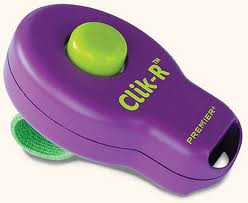Dear Denise,
We just adopted a new puppy and I’ve been reading a little about “clicker training”. How does clicker training work and do you think it’s effective? Can a dog of any age respond to clicker training?
Dear Mama,
Clicker training is AWESOME! I can’t say enough good things about it. It’s how I teach my pets and what I teach clients. So, I’m thrilled you asked.
Clicker training is an animal training method (not just for dogs) that is based on the principles of behavioral psychology. It relies on positive reinforcement by ‘marking’ desirable behavior and then rewarding it. Generally, unwanted behavior is s imply ignored.
imply ignored.
In the case of ‘clicker’ training, desirable behavior is marked using the distinct sound of a clicker at the exact instant the animal offers the desired behavior. For example, as soon as your puppy’s bottom touches the floor, you click. It doesn’t matter if your pup doesn’t hold the “sit”, you’ve ‘marked’ the correct behavior with a distinct cue. Without the clicker, you’d have likely said “good sit” right about the time your puppy jumped up again and then given a treat as he climbed on your lap. You’d have been reinforcing getting up, not putting his bottom on the ground.
Another example of ‘clicker training’ and how it works is in marine mammal training. Marine mammal trainers having been teaching complicated behaviors for years without leashes, collars or corrections. When the animal offers a desired behavior, he hears a whistle and gets a fish. If the animal is being naughty or unruly, as they sometimes are, the trainer simply packs up his treats and leaves the training area — quite a bummer if you really like fish!
The greatest thing about this method of training is that it actually teaches your dog to think. Now, you may be thinking you don’t need anybody else in the house trying to outsmart you, but what the animal is thinking is ‘How do I make those clicks happen?’ Sometimes, they can get really creative and offer the cutest behaviors. This method also builds confidence in your animal because he will be hearing a lot more yeses than nos, and who doesn’t like that?
As for teaching an old dog new tricks, it can be done. We calls those dogs ‘crossover dogs.’ it can take them a bit longer to catch on to the creative part of the game and begin to offer novel behaviors, but generally, once you load the clicker (give it meaning by clicking and treating a few times), you can begin training. I’d suggest starting with something new, easy and unimportant, like a shake or touching a target, and remember, I said earlier, this isn’t just for dogs.
You can use this method for teaching just about any other animal. I’m currently using it with cats, birds and ponies. So, if you happen to have a pet rat, give it a try; rats are smart! You can even use these simple principles of positive reinforcement on your husband and kids! Check out the book “Don’t Shoot the Dog,” by Karen Pryor. Just don’t tell your hubby I suggested it (and don’t click him, he wont think it’s near as funny as I do).
For more information on clicker training, check out the website www.clickertraining.com, or if you’d like to schedule a session to make sure you get started in the right direction, give me a call 479-225-6063.
 Thanks for the question and Happy Clicking!
Thanks for the question and Happy Clicking!
Denise
Denise Holmes is a pet behavior counselor with over 25 years of experience. She focuses on family pet training and animal-assisted therapy. She has consulted with Arkansas Children’s Hospital, helped set up a variety of local programs and produced a CD to help expecting parents introduce the family pet to a newborn, www.LoveTrustTeach.com.
Photo credit: Bijoubaby via Flickr





